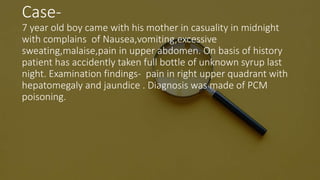
PARACETAMOL POISIONING.pptx
- 1. Case- 7 year old boy came with his mother in casuality in midnight with complains of Nausea,vomiting,excessive sweating,malaise,pain in upper abdomen. On basis of history patient has accidently taken full bottle of unknown syrup last night. Examination findings- pain in right upper quadrant with hepatomegaly and jaundice . Diagnosis was made of PCM poisoning.
- 3. Introduction • Paracetamol is also known as acetaminophen, n-acetyl-p- aminophenol,4-hydroxyacetanilide. • Physical appearance- exists as white odourless bitter tasting cystal or crystalline powder • Uses- 1) Antipyretics- in 1893 von mering introduced paracetamol into pharmacotherapeutics. It is active metabolite of acenilide and phenacetin 2) Analgesic
- 4. Mode of action • Paracetamol rapidly and completely absorbed from gi tract • Peak plasma levels are reached in 1hr • Plasma half life is about 2hrs • Absorption is delayed by high carbohydrate foods • Protein binding for paracetamol is 20% • Volume of distribution is 0.8 to 1l/kg • Normally 90% of the drugs undergoes hepatic conjugation with glucuronide and sulphuric acid to form inactive and harmless metabolites
- 5. • 10% is oxidised to n-acetyl-p-benzo quinonines(NAPQI) which is highly reactive intermediate • NAPQI is capable of covalent binding and arylating critical cell proteins inducing a series of events that result in cell death • Normally glutathione detoxifies NAPQI to cysteine and mercapturate conjugates which is secreted through urine • In overdose situation glutathione stores become depleted and NAPQI binds covalently with hepatocytes of liver causing centrilobular hepatic necrosis • Concomitant intake of drugs induces P450 enzymes can enhance the chance of hepatoxicity
- 6. • Toxic features- 1) Acute poisoning- clinical manifestation of acetaminophen intoxication are described in 4 stages STAGE 1- (1/2 hrs to 24hrs)- anorexia,vomiting,sweating,malaise STAGE 2-(24 hrs to 72hrs)-s symptom free stage,only right upper quadrate pain,LFT is normal STAGE 3-(72 to 96hrs) phase of peak Hepatic necrosis sets in with conjugation defects.jaundice and encephalitis nausea,vomiting reappears Elevated blood levels of liver enzymes(SGOT/ALT,SGPT/AST) Increased total bilirubin and prolonged PT is seen Decreased serum IL-6 Acute renal failure
- 7. STAGE 4( 4 days to 2 weeks) phase of recovery If the patient survives the 3rd stage complete resolution of hepatic damage is the rule. There is no reported cause of chronic hepatic dysfunction from paracetamol ADDITIONAL MANIFESTATION- Hypotension and shock with hypothermia in absence of hepatic dysfunction have been reported in acute paracetamol poisoning the mechanism is unclear
- 8. 2) Chronic poisoning This is common in alcoholics ,AIDS patients,T.B patients where individuals has consumed large doses of paracetamol over period of time for relief of chronic pain This is also very common in children because of dose miscalculation by parents it presents with low body temperature,hepatomegaly,anorexia,vomiting Fatal Dose- 20-25 grams Children under the age of 10 years appears to be more resistant to the toxic effects of paracetamol. It has been suggested that toxic dose of 5year old child is 187.5mg/kg Fatal time- 3 days
- 9. Diagnosis • Serum paracetamol levels should be measured after 4 hrs • AST and ALT level-10,000 units/l within 72 to 96hrs • Total bilirubin level- 4 mg/100 ml(which may be fatal) • 150 mg/kg is the lowest acute dose of pcm capable of hepatotoxicity • Diagnosis of hepatotoxicity is done by RUMACK MATTHEW NOMOGRAM • RUMACK MATTHEW NOMOGRAM is not useful in- Poisoning with sustained release formulations Chronic poisoning Pcm ingested with anticholinergics or opiods
- 11. Management 1. Gastric lavage within 4hrs 2. ANTIDOTE- a) N Aetaly cysteine (NAC) is the specific antidode and is used orally within 16hrs after ingestion. It is not effective if given after 24hrs of in gestion Dose-140mg/kg f/b 70mg/kg every 4hrs for 17dose(18 doses) MOA- It prevents binding NAPQI to hepatocytes Directly binds to NAPQI Enhances synthesis of glutathione Containdication of NAC oComa,vomiting,hepatic failure,encephalopathy oPretreatment with activated charcoal NAC can be administered orally of I/V
- 12. b)Methionine I. Oral antidote II. Glutathione precursor III. Dose-2.5gm 4hrly interval upto 4 doses c)Cysteamine Kings college criteria for PCM poisoning are used for deciding referral for liver transplantation 1. Acedimia ( serum pH<7.3) 2. Coagulopathy(INR>6) 3. Renal dysfunction( creatinine > 3.4mg/dl) 4. Grade III or IV hepatic encephalopathy
- 13. Medicolegal importance • Mostly suicidal rarely accidental • Organ donation after pcm poisoning can be done • Homicidal poisoning virtually unknown because large dose required
- 15. Thank you